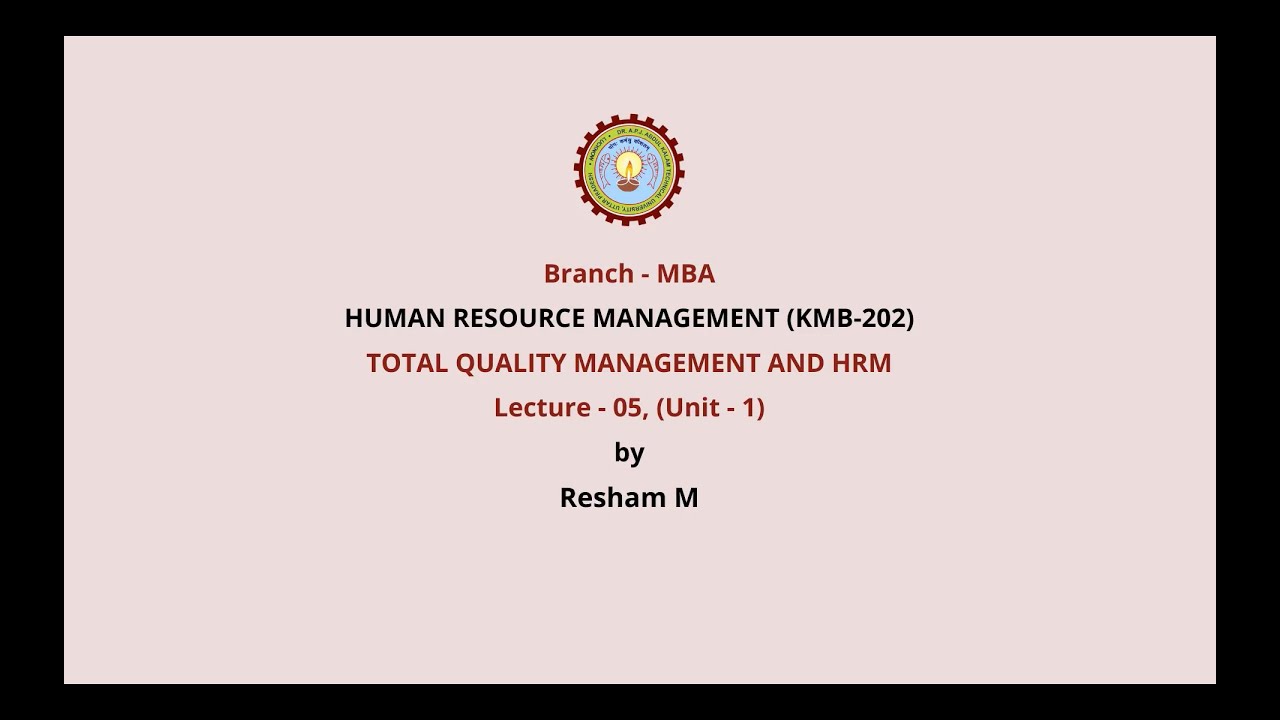Strategic Human Resource Management MGMT 430
Summary
TLDRThis lecture delves into Strategic Human Resource Management, emphasizing the importance of aligning HR activities with the corporate strategy. It discusses various approaches to strategic HR, debunking the idea of a one-size-fits-all strategy and highlighting the need for HR to adapt based on the company's mission, vision, and competitive advantage. The lecture also explores different corporate strategies, such as growth, stability, and retrenchment, and how they influence HR practices, including hiring, training, compensation, and performance appraisals, to ensure they support the company's strategic direction.
Takeaways
- 😀 Strategic HRM is about aligning HR activities with the company's mission, vision, and strategy to support the overall corporate direction.
- 📈 There is no one-size-fits-all approach to HR; strategies must be contingent upon the company's specific strategy, culture, and external factors like geographic and economic conditions.
- 🛠 Different companies may require different HR practices; for example, selective hiring may be essential for a tech company but not for a fast-food chain.
- 💼 The HR function should focus on extensive training and sharing financial performance information with employees to foster a sense of ownership and understanding of the company's goals.
- 🔄 Traditional HR was more micro and short-term focused, while strategic HR adopts a long-term, innovative, and adaptive approach, considering employees as contributors to the company's success.
- 🌟 Companies have unique strategies; for instance, Apple may offer high compensation tied to performance, whereas McDonald's competes on price and consistency, not on high compensation.
- 🏢 Corporate strategy dictates the overall direction, while business-level and functional-level strategies ensure that each division and department aligns with and supports the corporate goals.
- 🛑 Retrenchment strategies involve reducing the scale of operations, which may affect HR practices such as hiring and compensation, focusing more on cost-cutting and efficiency.
- 💡 Porter's differentiation strategy allows companies to charge more for innovation, quality, and customer service, influencing HR practices like selective hiring and high compensation.
- 📊 In a cost leadership strategy, companies compete on price, which means HR practices focus on cost efficiency, possibly resulting in lower compensation and a stronger emphasis on cost management.
- 🔍 Miles and Snow's typology includes Prospectors, Defenders, Analyzers, and Reactors, each with different market approaches that shape HR strategies and activities.
Q & A
What is the primary role of Human Resource Management (HRM) in relation to corporate strategy?
-The primary role of HRM is to align its activities with the corporate strategy of the business. It ensures that all people-related issues are in connection with the company's mission, vision, and strategic direction.
Why is it important for HR to adapt its strategies based on the way businesses compete?
-It is important for HR to adapt because different businesses may compete on different factors such as price or innovation. HR strategies must support the company's competitive advantage, which may vary based on the business model.
What are some examples of traditional HR practices that may not fit all organizations?
-Examples of traditional HR practices that may not fit all organizations include self-managed teams, selective hiring, and high compensation contingent on performance. These practices work well for some companies like Apple but not for others like McDonald's, which has a different competitive advantage.
How does McDonald's compete in the market, and why does this affect its HR strategy?
-McDonald's competes on the consistency of its products at a reasonable price, not on innovation or high quality. This means their HR strategy focuses on training for efficiency rather than selective hiring or high compensation.
Why is extensive training important for a company like Walmart or McDonald's, regardless of their overall strategy?
-Extensive training is important because it helps employees understand how to minimize costs, which is crucial for companies competing on low prices. Training ensures that employees contribute effectively to the company's competitive advantage.
What is the significance of sharing financials and performance information with employees, and how does it relate to HR strategy?
-Sharing financials and performance information with employees is significant because it improves transparency and buy-in to the company's goals. It is part of HR strategy to ensure employees understand the company's performance and their role in achieving objectives.
How does the best practices approach in HR strategy differ from the 'it depends' approach?
-The best practices approach suggests there are certain universal practices that work best for all companies. In contrast, the 'it depends' approach acknowledges that HR strategies must be contingent upon the company's specific strategy, culture, and external constraints.
What are some factors that HR needs to consider when scanning the environment for strategic planning?
-Factors include geographic issues, cultural differences, labor force skills and abilities, economic conditions, and regulatory environments. These factors influence how HR strategies are adapted to meet the company's goals.
How does the transition from traditional HR to strategic HR change the focus of HR activities?
-The transition shifts the focus from a narrow, short-term approach to a more strategic, long-term perspective. HR activities become more adaptive, innovative, and aligned with the company's mission and vision, emphasizing employees as contributors to the bottom line.
What is the difference between corporate strategy, business-level strategy, and functional-level strategy?
-Corporate strategy defines the overall mission, vision, and direction of the company. Business-level strategy pertains to how individual divisions or business units within the company operate to support the corporate strategy. Functional-level strategy involves the strategies of individual departments, such as HR, to ensure their activities align with the company's goals.
Outlines

このセクションは有料ユーザー限定です。 アクセスするには、アップグレードをお願いします。
今すぐアップグレードMindmap

このセクションは有料ユーザー限定です。 アクセスするには、アップグレードをお願いします。
今すぐアップグレードKeywords

このセクションは有料ユーザー限定です。 アクセスするには、アップグレードをお願いします。
今すぐアップグレードHighlights

このセクションは有料ユーザー限定です。 アクセスするには、アップグレードをお願いします。
今すぐアップグレードTranscripts

このセクションは有料ユーザー限定です。 アクセスするには、アップグレードをお願いします。
今すぐアップグレード関連動画をさらに表示

MBA 101 Strategic HRM, Introduction

Human Resource Management (HRM) Explained in 10 minutes

Human Resource Strategy and Planning

HR Basics: Human Resource Management

Planejamento Estratégico de Negócios - Planejamento de recursos humanos

Human Resource Management | Total Quality Management and HRM | AKTU Digital Education
5.0 / 5 (0 votes)
